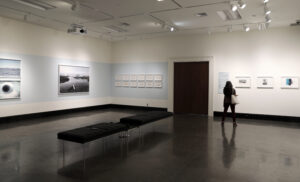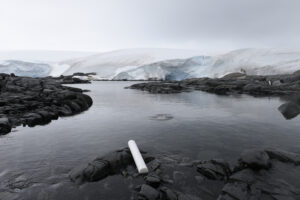Art learning from science learning from art: worlds colliding in new Arctic exhibit
If you could write a letter to someone 1,000 years from now, what would you say? And what would they think of the world today when reading it?
These are some of the questions posed to visitors walking through the Vanderbilt University Museum of Art’s newest exhibit, …no footprints, even, co-curated by Jana Harper, professor of the practice of art, and Lutz Koepnick, Max Kade Foundation Chair in German Studies, in collaboration with the museum’s curator Rachel P. Kreiter, who organized the exhibit.
 The exhibit features the multi-disciplinary work of Montréal-based artist Jessica Houston. It explores relationships between art and science, the history of polar travel and exploration, the poetry of human existence on Earth, and the future of ice on our overheating planet.
The exhibit features the multi-disciplinary work of Montréal-based artist Jessica Houston. It explores relationships between art and science, the history of polar travel and exploration, the poetry of human existence on Earth, and the future of ice on our overheating planet.
“This body of work addressing climate and the polar regions is critical right now,” Harper said. “It is also beautiful art. Jessica is an incredibly thoughtful, dexterous artist. She talks about serious issues, but with a quiet voice. Her gentle touch really invites us to listen and contemplate the systems that surround us—be they cultural, empirical, or spiritual. It also asks us to consider our obligations to both the past and the future, which seems extremely relevant to our students right now.”
The exhibit features Letters to the Future, a collaborative project in which Houston placed 22 hand-written letters from various artists, scientists, composers, writers, and public intellectuals into a time capsule in a slowly-moving glacier in Antarctica to be opened 1,000 years in the future. The show also presents three other related bodies of work from recent years, all using different media to engage with the legacy of polar travel and exploration: Over the Edge of the World; The Yelcho Expedition of the Antarctic, 1909-1910; and The Magnetic Observatory.
“Scientific and artistic inquiry both begin with observation,” said Amanda Hellman, director of the museum and senior lecturer of history of art and architecture. “From that starting point, … no footprints, even visually explores how these disciplines help us understand human connection, the drive for discovery, spirituality, and the unseen forces that shape our world.”
Moving through the exhibit, Houston’s work combines art and science in a literal sense, from calculating the appropriate depth and location in the glacier to place the time capsule for it to reemerge in 1,000 years, to visually interpreting the invisible power of magnetic fields.
 To Harper and Koepnick, the connection between art and science benefits both fields.
To Harper and Koepnick, the connection between art and science benefits both fields.
Koepnick said, “Artists can certainly learn a thing or two from how scientists develop hypotheses and pursue their research. But our hope is that this can also go the other way around—that a scientist can learn how artists ask their questions outside-of-the-box and invite us to rethink what may count as a valid question in the first place. Art, we believe, has a huge and often undervalued potential to bring different disciplines, different ways of knowing the world, into productive conversations.”
Harper continued, “What amazes me about Jessica’s work is its interdisciplinary and collaborative spirit. As an artist myself, I really appreciate how far she goes in mending the fissure between the humanities and the sciences, and her work is a beautiful example of how they can really support one another. Her thinking is so expansive that even a glacier becomes a collaborator. This exemplifies the kind of creativity that is so important to share with students these days.”
Koepnick and Harper are no strangers to the curatorial world. Harper previously served as the director of COOP Gallery in Nashville, and Koepnick co-curated several exhibitions at the Mildred Lane Kemper Art Museum in St. Louis, Missouri.
“We love to talk about the root of the word curator, curare, which means to care for. In many ways it’s an act of generosity,” Harper said. “It’s an act of sharing. It’s an act of inclusion. We have thought a lot about the art landscape in Nashville—what’s here, what isn’t here, and how we might contribute to it with this show.”
Koepnick continued, “For me, one of the really exciting challenges of curating this show was to find appropriate ways of writing and talking about the work that echo Houston’s ideas about us leaving as few footprints as possible on this planet. How can one write about Houston’s work from a position of care and without assuming the role of a detached critic? What can we do with our wall texts to reveal some of the show’s key themes to audiences with very different backgrounds? And how can we as curators invite viewers to engage with the work and thereby enable reciprocal processes of growth, inspiration, and enrichment?”
Houston’s work will be on display at the museum through May 11.
Read Koepnick’s essay on Houston’s work, “Antarctic Meditations.”

Archival Digital Print
48 x 72“ (122 x 183 cms)
